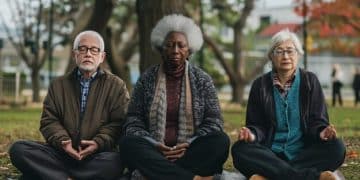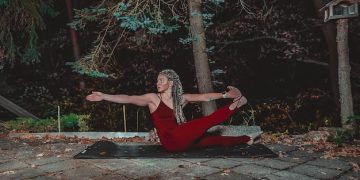Pilates vs. Yoga: Core Strength and Stability Face-Off
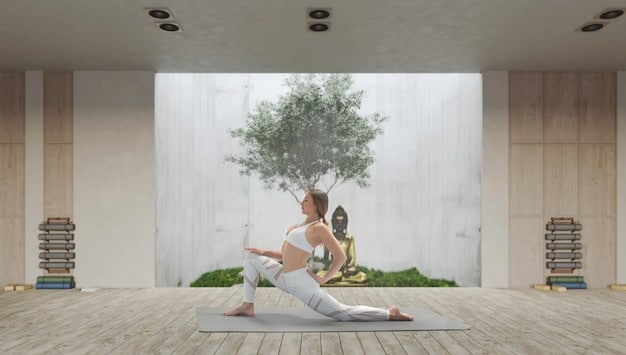
Pilates and yoga both improve core strength and stability, but Pilates emphasizes precise movements targeting deep core muscles, while yoga integrates core work with flexibility and balance through various poses.
Choosing between Pilates and yoga for improving your core strength and stability can seem daunting. Both practices offer unique benefits, but understanding their differences will help you decide which is the better fit for your fitness goals. Let’s dive into a comprehensive comparison of Pilates vs. Yoga: Which is Better for Core Strength and Stability?
Pilates vs. Yoga: An Overview
Pilates and yoga are popular exercise methods known for their positive impact on physical and mental well-being. Both practices focus on building strength, improving flexibility, and enhancing body awareness. However, they approach core strengthening and stability from different angles.
Understanding the unique aspects of each can help you determine which method aligns better with your fitness objectives and preferences.
The Essence of Pilates
Pilates focuses on controlled movements and precise techniques that target the deep core muscles. Developed by Joseph Pilates, this method aims to strengthen the body’s “powerhouse,” which includes the abdomen, lower back, hips, and glutes.
- Emphasis on Core Engagement: Pilates routines intentionally engage the core throughout each exercise, promoting stability and strength.
- Equipment-Based Exercises: Pilates often utilizes specialized equipment like the Reformer, Cadillac, and Wunda Chair to provide resistance and support.
- Focus on Posture and Alignment: Proper alignment and posture are central to Pilates, helping to correct imbalances and prevent injuries.
The Essence of Yoga
Yoga, originating from ancient Indian traditions, integrates physical postures, breathing techniques, and meditation. While yoga encompasses a wide range of styles, many forms emphasize core strength as a foundation for overall stability and balance.
- Diverse Styles: From gentle Hatha to dynamic Vinyasa and strength-focused Power Yoga, there are many styles to choose from, each with varying degrees of core engagement.
- Bodyweight Exercises: Yoga predominantly relies on bodyweight for resistance, challenging the core to stabilize and support different poses.
- Mind-Body Connection: Yoga emphasizes the connection between the mind and body, promoting relaxation and stress reduction in addition to physical benefits.
In conclusion, both Pilates and yoga significantly contribute to core strength and stability, though their methodologies vary. Pilates concentrates on precise core engagement and equipment-assisted exercises, while yoga integrates core work with flexibility and balance through diverse bodyweight postures.
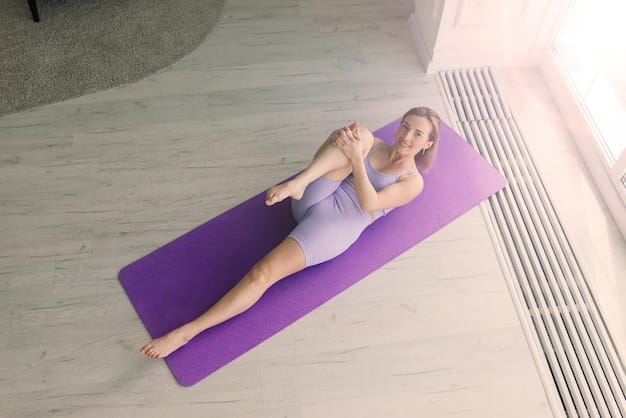
Core Muscle Activation: Pilates vs. Yoga
When comparing Pilates vs. Yoga: Which is Better for Core Strength and Stability? it’s crucial to analyze how each method activates and engages the core muscles. While both are effective, they target the core in different ways, leading to varied outcomes.
Understanding these differences can help you decide which practice is more suitable for your specific needs and goals.
Pilates: Targeted Core Engagement
Pilates is renowned for its highly targeted approach to core engagement. Every exercise is designed to activate the deep core muscles, ensuring continuous support and stability throughout the workout.
This method focuses on precision and control, making it an excellent choice for those looking to strengthen specific core areas.
- Transverse Abdominis Activation: Pilates emphasizes the activation of the transverse abdominis, the deepest abdominal muscle, which acts like a natural corset for the torso.
- Oblique Strengthening: Many Pilates exercises target the obliques, contributing to rotational stability and a more defined waistline.
- Lower Back Support: By strengthening the core, Pilates also provides essential support for the lower back, reducing the risk of back pain and injuries.
Yoga: Holistic Core Integration
Yoga integrates core engagement into a broader range of movements and poses. While some yoga styles specifically target the core, others incorporate core strength as a natural component of overall stability and balance.
This holistic approach ensures that the core works in harmony with other muscle groups, promoting functional strength and flexibility.
- Plank Variations: Yoga includes numerous plank variations that challenge the core to stabilize the body in different positions, building strength and endurance.
- Balancing Poses: Poses like tree pose and warrior three require significant core engagement to maintain balance, enhancing proprioception and coordination.
- Twisting Asanas: Twisting poses in yoga help strengthen the obliques and improve spinal mobility, contributing to a well-rounded core workout.
In summary, Pilates offers a highly targeted approach to core activation, focusing on precision and control, while yoga integrates core engagement into a holistic practice that promotes overall stability and balance.
Equipment vs. Bodyweight: Which Method Wins?
One of the key differentiators when considering Pilates vs. Yoga: Which is Better for Core Strength and Stability? is the use of equipment versus bodyweight exercises. Each approach has its advantages and disadvantages, influencing the type of core strength and stability developed.
The choice between equipment-based and bodyweight training depends on individual preferences, fitness goals, and access to resources.
Pilates Equipment: Resistance and Support
Pilates often utilizes specialized equipment, such as the Reformer, Cadillac, and Wunda Chair, to provide resistance and support during exercises. These machines allow for precise and controlled movements, making Pilates accessible to individuals of all fitness levels.
The equipment can also help isolate specific muscle groups, ensuring targeted core engagement.
- Adjustable Resistance: Pilates equipment offers adjustable resistance levels, allowing users to gradually increase the challenge as their strength improves.
- Assisted Movements: The equipment can assist with certain movements, making them easier for beginners or those with limited mobility.
- Enhanced Core Isolation: Pilates equipment helps isolate and target specific core muscles, promoting efficient and effective strengthening.
Yoga: Bodyweight Challenges
Yoga primarily relies on bodyweight for resistance, challenging the core to stabilize and support the body in various poses. This approach promotes functional strength, which translates to improved performance in everyday activities.
Bodyweight exercises in yoga require a high degree of control and awareness, fostering a strong mind-body connection.
- Functional Strength: Bodyweight exercises in yoga build functional strength that is directly applicable to real-life movements and activities.
- Accessibility: Yoga can be practiced anywhere, anytime, without the need for specialized equipment.
- Proprioception: Balancing poses and dynamic movements in yoga enhance proprioception, improving body awareness and coordination.
In conclusion, Pilates equipment offers adjustable resistance and targeted muscle isolation, while yoga’s bodyweight exercises promote functional strength and accessibility. The choice between the two depends on individual preferences and fitness goals.
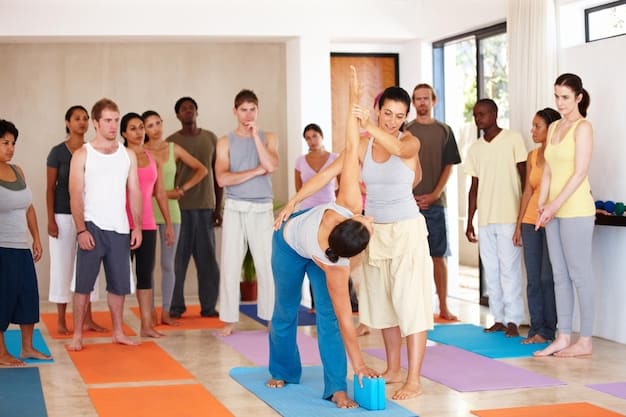
Flexibility and Range of Motion: Pilates vs. Yoga
Another important factor to consider when discussing Pilates vs. Yoga: Which is Better for Core Strength and Stability? is the impact on flexibility and range of motion. Both practices enhance these aspects of physical fitness, but they do so through different mechanisms.
Understanding these differences can help you choose the practice that best supports your overall flexibility and mobility goals.
Pilates: Controlled Flexibility
Pilates focuses on controlled movements that gradually increase flexibility and range of motion. The emphasis on precise technique and proper alignment ensures that stretches are performed safely and effectively. Pilates routines often include exercises that lengthen and strengthen muscles simultaneously, promoting balanced flexibility.
- Muscle Lengthening: Pilates exercises are designed to lengthen muscles, improving flexibility without compromising strength.
- Joint Mobility: Controlled movements in Pilates enhance joint mobility, reducing stiffness and improving range of motion.
- Balanced Flexibility: Pilates promotes balanced flexibility by addressing muscle imbalances and promoting symmetrical strength.
Yoga: Deep Stretching
Yoga is renowned for its deep stretching and varied poses that enhance flexibility and range of motion. Many yoga styles involve holding poses for extended periods, allowing for deeper muscle relaxation and increased flexibility. Yoga also incorporates breathing techniques that can help release tension and improve the effectiveness of stretches.
- Static Stretching: Holding yoga poses for extended periods allows for deep static stretching, promoting muscle relaxation and increased flexibility.
- Dynamic Movements: Vinyasa and other dynamic yoga styles incorporate flowing movements that improve range of motion and flexibility.
- Mindful Stretching: Yoga encourages mindful stretching, which involves paying attention to the body’s sensations and respecting its limits, reducing the risk of injury.
In summary, Pilates offers controlled flexibility through precise movements, while yoga promotes deep stretching through varied poses. The choice between the two depends on individual preferences and goals related to flexibility and range of motion.
Mental and Emotional Well-being: Pilates vs. Yoga
Beyond the physical benefits, both Pilates and yoga significantly contribute to mental and emotional well-being. When comparing Pilates vs. Yoga: Which is Better for Core Strength and Stability? it’s essential to acknowledge the impact on stress reduction, mindfulness, and overall mental health.
Choosing between the two may depend on which aligns better with your mental and emotional needs.
Pilates: Focus and Precision
Pilates emphasizes focus and precision during each movement, requiring individuals to be fully present and engaged in the exercise. This mental focus can help reduce stress and improve concentration. The controlled nature of Pilates can also be meditative, promoting a sense of calm and well-being.
- Mind-Body Connection: Pilates fosters a strong connection between the mind and body, enhancing body awareness and proprioception.
- Stress Reduction: The focus on precise movements and controlled breathing in Pilates can help reduce stress and promote relaxation.
- Improved Concentration: Regular Pilates practice can improve concentration and mental clarity.
Yoga: Mindfulness and Meditation
Yoga integrates mindfulness and meditation into its practice, promoting relaxation and stress reduction. Many yoga styles incorporate breathing techniques (pranayama) and meditative practices that can help calm the mind and improve emotional well-being. Yoga encourages self-acceptance and non-judgment, fostering a positive body image and sense of inner peace.
- Stress Management: Yoga’s breathing techniques and meditative practices are effective tools for managing stress and anxiety.
- Emotional Well-being: Yoga promotes emotional balance and self-awareness, fostering a greater sense of inner peace and contentment.
- Mindfulness: Regular yoga practice cultivates mindfulness, helping individuals to be more present and engaged in their daily lives.
In conclusion, Pilates fosters focus and precision, reducing stress and improving concentration, while yoga integrates mindfulness and meditation, promoting relaxation and emotional well-being. The choice between the two depends on individual preferences and mental health goals.
Choosing the Right Practice for You
Deciding between Pilates vs. Yoga: Which is Better for Core Strength and Stability? involves considering your individual goals, preferences, and physical condition. Both practices offer significant benefits, but one may be more suited to your specific needs.
Here are some factors to consider when making your choice.
Consider Your Goals
Think about what you hope to achieve through your exercise practice. If your primary goal is to build targeted core strength and improve posture, Pilates may be the better choice. If you’re looking for a holistic practice that integrates core strength with flexibility, balance, and mindfulness, yoga may be more appealing.
Both can contribute to overall fitness, but understanding your priorities will guide your decision.
Consider Your Physical Condition
Assess your current physical condition and any existing injuries or limitations. Pilates is often recommended for individuals with back pain or those recovering from injuries, as it emphasizes controlled movements and proper alignment. Yoga offers a wide range of styles, making it adaptable to various fitness levels and physical conditions. However, certain yoga poses may be challenging for those with joint issues or other limitations.
- Injuries: If you have injuries, consult with a healthcare professional before starting any new exercise program.
- Fitness Level: Consider your current fitness level and choose a practice that is appropriately challenging yet manageable.
- Personal Preferences: Ultimately, the best practice is the one you enjoy and are more likely to stick with long-term.
In summary, consider your goals, physical condition, and personal preferences when choosing between Pilates and yoga. Both practices offer unique benefits for core strength, stability, and overall well-being, so the best choice is the one that aligns with your individual needs and preferences.
| Key Point | Brief Description |
|---|---|
| 💪 Core Engagement | Pilates targets deep core muscles; Yoga integrates core with balance. |
| 🏋️ Equipment vs. Bodyweight | Pilates uses machines for resistance; Yoga uses bodyweight. |
| 🧘 Flexibility | Pilates offers controlled flexibility; Yoga provides deep stretching. |
| 🧠 Mental Well-being | Pilates enhances focus; Yoga promotes mindfulness and stress reduction. |
Frequently Asked Questions
▼
Both are suitable for beginners, but Pilates may be better if you prefer structured, guided movements. Yoga’s diverse styles allow beginners to start with gentler forms like Hatha.
▼
Yes, combining Pilates and yoga can provide a well-rounded fitness routine. They complement each other, enhancing core strength, flexibility, and mental well-being.
▼
While neither is primarily for weight loss, both can contribute. Yoga, especially dynamic styles, burns more calories. Pilates builds muscle which boosts metabolism. A balanced diet is also essential.
▼
Pilates is often recommended for back pain due to its focus on core strength and proper alignment. Some yoga styles can also help, but avoid poses that exacerbate pain.
▼
Aim for at least 2-3 times a week to see noticeable benefits. Consistency is key. Listen to your body and adjust frequency based on your fitness level and goals.
Conclusion
In conclusion, both Pilates and yoga offer unique pathways to enhancing core strength and stability, each with its own set of advantages. By carefully considering your personal fitness goals, preferences, and physical condition, you can determine which practice aligns best with your needs, fostering a stronger, more balanced, and healthier you.
